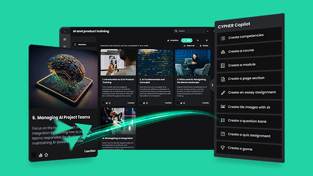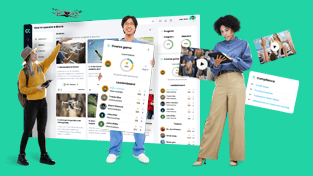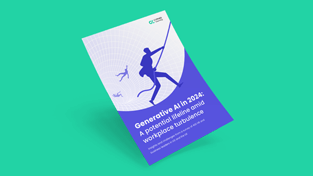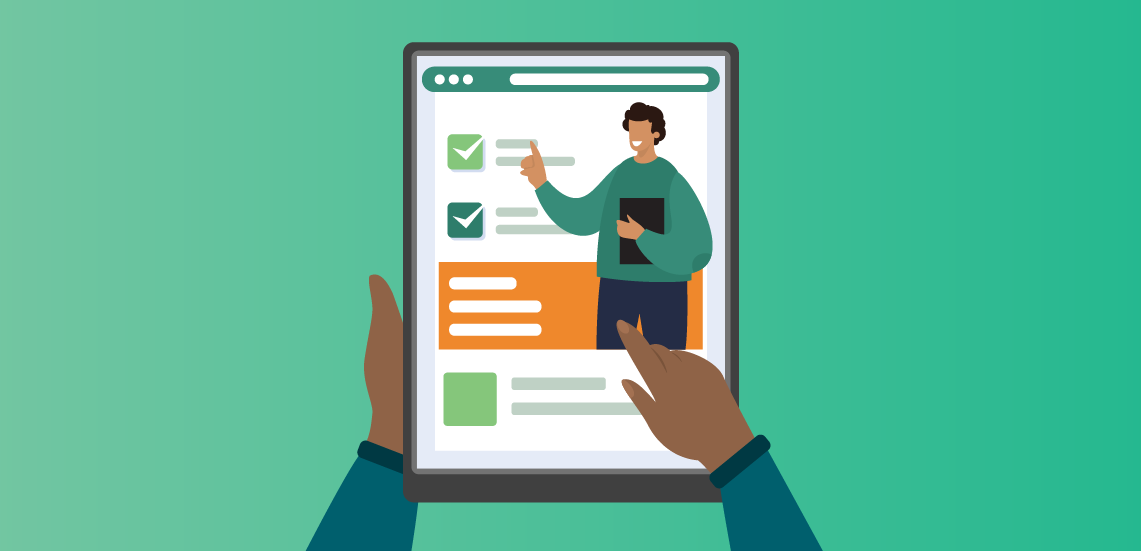Teaching constantly meets new challenges. If frontal lessons were the norm decades ago, things have changed significantly. The focus is now on students and making classes interactive by encouraging student participation.
All educational acts should and usually do revolve around them. The purpose of education is no longer to pass on theoretical knowledge. What matters the most is to equip students with future-ready skills to become well-rounded adults ready to thrive in their lives and careers.
Competency-based education plays an essential role in this endeavor. As its name suggests, this type of learning focuses on individual competency. It promotes a learner-centric approach in which students get from level A to level B after acquiring and demonstrating mastery of certain skills.
Competency-based learning is easier to implement when you have the right tools. An intelligent learning platform (ILP) is the ideal option. This technology already incorporates all the features you need to implement a competency-based learning model.
Learn how an ILP enables competency-based education.
Read more: What is an intelligent learning platform for schools and universities?
What is competency-based education?
Competency-based education (CBE) is a method of instruction and evaluation in which the student demonstrates mastery of specific subjects.
According to the Aurora Institute, competency-based education definition incorporates the following seven components:
- Students are empowered to make decisions regarding their learning (how they create and apply knowledge, and how they prove their acquired competencies);
- Assessment is meaningful and it becomes a positive and empowering experience for learners who gain actionable insights as a result;
- Students receive personalized support from teachers based on their individual needs;
- Student progress is measured based on the concrete skills they can demonstrate, not on class attendance;
- Students can engage in learning at their own pace and use different personalized learning paths;
- The education system and the teacher’s personal pedagogical approach aim to ensure equity for all students;
- The learning goals are explicitly and transparently stated; students know the skills they must acquire by achieving concrete, measurable goals.
Competency-based education models integrate all the seven elements. Now, let’s explore the major benefits of competency-based learning.
How does competency-based education differ from traditional models?
The main difference between traditional learning models and competency-based learning is that the first prioritizes “seat time” while measuring success. In a competency-based model, students’ progress is measured based on mastery and not how much time they’ve spent in the classroom.
To make things clearer, think about the typical standard unit used for measuring progress in most colleges and universities – the credit hour. This system has prevailed for years and it is still the most widespread progress measuring method. However, it is not necessarily the most efficient one. Competency-based learning aims to change the status quo by emphasizing personalized learning paths and how students prove their learning.
In conclusion, CBE draws a clear line between “in seat” time and real academic progress. This change proves highly effective, especially for Higher Ed students who might have already acquired certain skills on the job or through informal learning. If they can prove mastery of those competencies, students can move further in their learning instead of being forced to attend classes on that same topic together with their colleagues.
What are the benefits of competency-based education?
Competency-based education has many advantages. Among them, you will find higher flexibility and student engagement, a more efficient and goal-oriented learning process, and plenty of benefits on the personal development side as students gain more confidence.
A more engaging learning experience
Listening to the teacher talk for hours and hours each semester without a chance to intervene can be boring, to say the least. It is also one of the reasons why many students fail to feel motivated and engaged in what is happening in the classroom. Even teachers who focus on student interaction still have problems engaging all the students in the class.
This is understandable. Not everyone can or wants to get the chance to speak during classes. By switching to a learner-centered teaching model and enabling students with the tools they need for efficient individual learning, teachers can tackle low engagement issues. Here is where online learning technologies such as ILPs step in.
Using an ILP, each student is motivated to progress by learning new topics in a digital, user-friendly, eye-catching environment. Interactive classes enriched with video content and gamification elements play an important role in keeping learners hooked and eager to move on to the next level. Moreover, students are in charge of managing the content. So, they don’t need to adapt to their colleagues’ pace. Once they’re done with their assessments, they can move on to the next chapter and complete classes faster, making the whole experience more engaging.
Improved confidence and self-assessment skills
Students need a sense of ownership and responsibility to meet tomorrow’s work environment standards. Competency-based learning contributes to this well-rounded student development as it focuses on measuring results. Only after a student proves mastery in a certain topic can they move on to the next one.
The progress is gradual and constantly monitored through repetitive assessments. There is no way to get to lesson seven if you haven’t proven that you’ve mastered the topics taught in the six previous lessons. This approach builds confidence over time. Students become fully aware of what they know and where they need to improve. They also become more engaged in the assessment process and eager to pass from one level to another.
Evaluation is no longer a threat, but a means to measure progress. This increases student motivation and makes them more capable of self-assessing their own skills, which will greatly benefit them in their careers.
More flexibility for students and teachers alike
CBE is highly learner-centered, which means that each individual’s needs are prioritized. Each learner's skills and knowledge gaps are at the center of the CBE approach. Tracking each student’s evolution and providing tailored educational content is the norm. This process can be simplified and optimized if you use an ILP.
The system automatically tracks each student’s progress and assesses their competencies. Only those who successfully pass each evaluation step can move on to more complex topics. The lessons and resources students receive on the platform are based on their mastery level. All these take a lot of work off teachers’ shoulders and empower students to grab control of their education through self-paced learning.
How to implement competency-based education through an intelligent learning platform?
ILPs enable competency-based education through their mastery features. To put it simply, schools and universities can upload or create a set of competencies on the platform. Teachers or administrators can easily do it themselves for their classes. After they’re done, they need to correlate the educational content (classes and assignments) with the competencies. This can easily be done on some platforms by simply tagging classes with corresponding competencies.
Then, as students navigate through their classes, they have to complete certain challenges such as solving a quiz or submitting a written assignment. With each type of assessment they successfully complete, the ILP recognizes the competencies they’ve acquired. In the end, all the competencies contribute towards achieving mastery in a certain subject.
-
Add competencies
Teachers can easily implement competencies in an ILP both for K-12 and Higher Ed, with zero technical background. Eductors can add as many competencies as they want to and track students’ progress based on these. The class content is associated with the competencies it should be teaching.
Teachers can also assess learners’ competencies very quickly via the ILP’s quiz system. This also works as a self-assessment method. Students complete quizzes by choosing the answers they consider correct, and the ILP automatically checks these tests and displays each student’s progress in an intuitive dashboard. This quick assessment type also allows teachers to spot knowledge gaps.
Read more: How to maximize skills or competency-based learning with CYPHER
-
Automate mastery
The example above shows just one of the capabilities ILPs have in automating competency-based learning. There are different other assessment formats teachers can use. Unless they ask students to submit written assessments (essays and freeform quiz questions, for example), the whole evaluation process is on autopilot. All the teacher has to do is make sure the correct answers are configured and the platform will check auto-graded quizzes.
Moreover, teachers will also see if their classes cover well all the competencies they have to teach, in other words, if they ensure mastery. They show the specific competencies and how much is covered and assessed throughout the class.
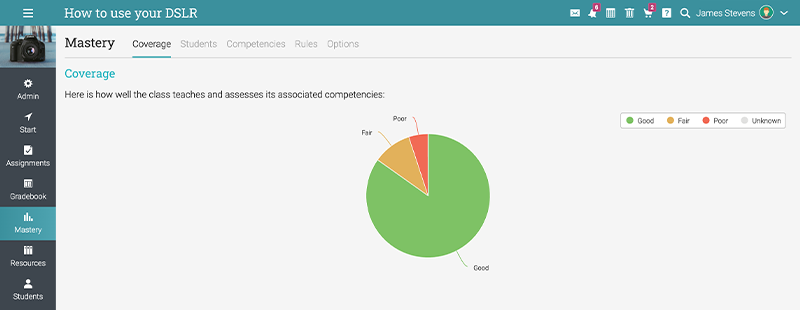 NEO displays mastery coverage as a pie chart or graph for each class.
NEO displays mastery coverage as a pie chart or graph for each class.Competencies that are not covered by any module or assignment will decrease the overall mastery level of the class, which can be expressed in percentages. Therefore, teachers can either add more content and tests that also cover that competency or eliminate and assign it to a more suitable class.
-
Track student progress based on competencies
Student progress is automatically tracked in an ILP. So, teachers don’t need to manually access each student’s profile and each individual assignment. They will get this information at a glance in the form of analytics.
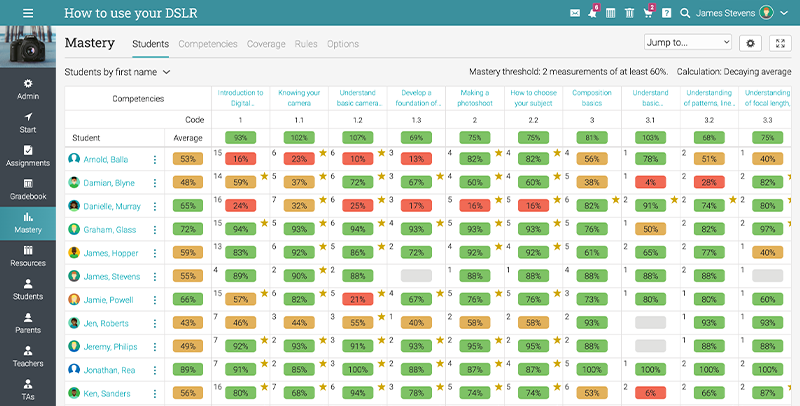 An overview of student progress when it comes to mastering individual competencies.
An overview of student progress when it comes to mastering individual competencies.Therefore, they can quickly look at the name of each student and immediately see how far they’ve reached in proving they master the competencies. Their submitted assignments, grades, dates, completed and ongoing classes and attendance stats can all be included in user-friendly, yet comprehensive reports.
Read more: 5 Must-have LMS reports for schools
-
Show competency-based content recommendations
ILPs can do more than help you assign and track class competencies and evaluate students. These smart platforms are infused with Artificial Intelligence (AI). Therefore, they scrutinize user behavior and provide the most suitable content recommendations based on each user’s mastery level.
 Content recommendations help students master competencies.
Content recommendations help students master competencies. Students who prove that they master specific competencies will receive access to classes or content that are more complex and explore the related topics in depth. On the other hand, those who find it hard to complete an assignment can receive recommendations suited to the beginner level. Instead of asking students to go multiple times through the same class, which can shake their engagement and confidence, the platform can recommend similar educational content from other sources such as online articles and explanation videos.
The advantages of using intelligent learning mastery features
Keeping track of student progress and knowing where and when each one of them falls behind is hard, especially in Higher Ed institutions where teachers deal with hundreds of students. However, the same applies to school teachers. Even in groups as small as 15 to 20 students, it’s next to impossible to keep in mind each student’s weak points and take action. However, an ILP acts as an assistant to track this for you.
Here are the main advantages of using an ILP to implement competency-based learning.
An accurate analysis of student performance
As previously highlighted, ILPs automatically track student activity and progress. Each class and assessment they complete helps them acquire more mastery. The platform calculates how far the student has reached, how much time they’ve spent in lessons, etc.
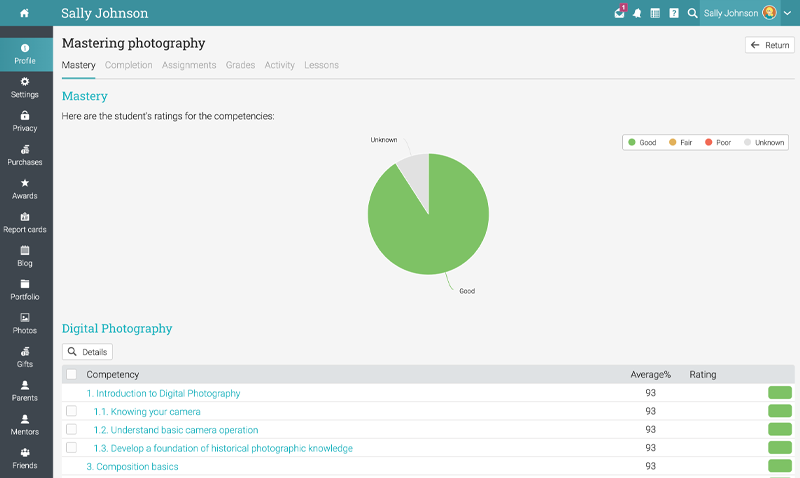 Students can easily see where they are and what they have to do to make progress.
Students can easily see where they are and what they have to do to make progress.
Increased flexibility for everyone
Both students and teachers enjoy a great deal of flexibility by engaging in CBE via an ILP. The first get the chance to learn at their own pace. Their progress is no longer influenced by how fast or slow the rest of the class is progressing. Students benefit from a personalized approach that allows them to spend just the right amount of time on learning each new topic.
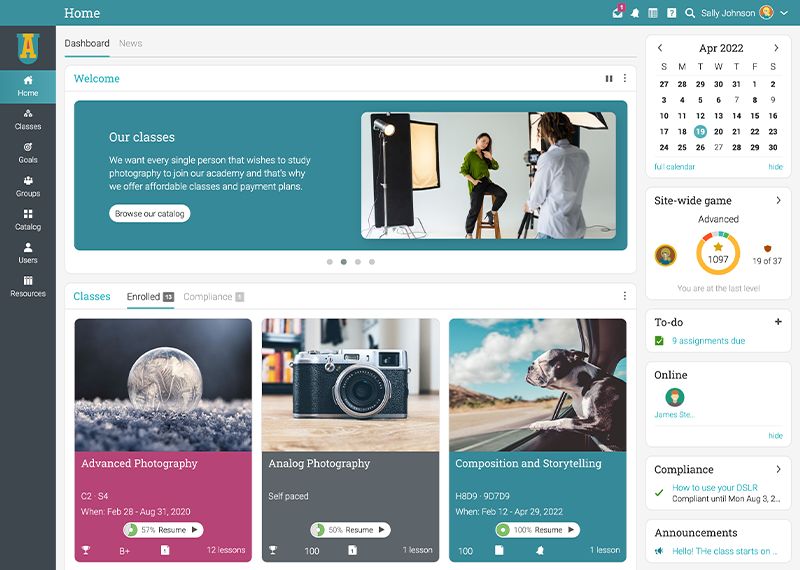 An intelligent learning platform is also intuitive, so students and teachers have all the important information at their fingertips.
An intelligent learning platform is also intuitive, so students and teachers have all the important information at their fingertips.
Moreover, they get access to educational content at any time from anywhere. Teachers also benefit from more flexibility as they reduce the amount of time spent in class and grading. They simply have to log into the platform when it best suits them to check student progress.
Building future-ready skills with personalized recommendations
I can’t stress enough the importance of providing students of all ages with real-life skills they will actually use. ILPs make it easier for teachers to achieve this goal via personalized recommendations. For example, if a student is interested in learning more about graphic design, the ILP won’t stop at providing them access to all the in-house classes that focus on this topic. It will also recommend third-party content such as courses from external providers (Udemy and the like), video tutorials, online articles, etc.
Making competency-based education possible
Competency-based education is the type of self-paced, goal-oriented learning students need today. This type of learning focuses on each student's needs and abilities and ensures everyone achieves mastery of a topic before they can move on to the next one. ILPs are the tools that can help teachers implement competency-based programs with ease, track student progress, and make sure each learner gets access to the best educational content based on their skills, goals, and interests.
